Get it while you still can: The Luxemburg-Gorky effect
by 13dka
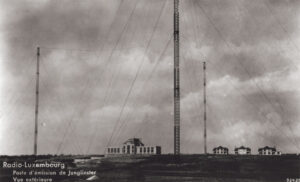
The Radio Luxembourg longwave transmitter Junglinster in the 1930s [RTL Group]
“In radiophysics, the Luxemburg-Gorky effect (named after Radio Luxemburg and the city of Gorky (Nizhny Novgorod)) is a phenomenon of cross modulation between two radio waves, one of which is strong, passing through the same part of a medium, especially a conductive region of atmosphere or a plasma.” (Wikipedia)
That sounds pretty abstract, right? In my own words, imagine your radio is tuned to a station on let’s say 162 kHz, 500 miles away. Somewhere in the middle between your receiver and the 162 kHz transmitter is a station transmitting on a different frequency, let’s say 234 kHz. The Luxemburg effect is that you can hear the modulation of the 234 kHz transmitter in the middle, on the 162kHz station you are receiving. The effect is not depending that much on the frequency/wavelength though, the longwave station could affect medium wave stations and it has been created using shortwave frequencies far apart.
It was observed first in 1932, when listeners of the Swiss Beromünster 60kW medium wave station built just one year prior also heard a bit of Radio Luxemburg’s longwave transmitter (250kHz) on the Beromünster frequency (653kHz until 1934). Of course this was assumed to be some kind of crosstalk within the receivers and probably drove radio engineers insane until 1933, when Bernhard D.H. Tellegen, a Dutch electrical engineer and inventor suggested the true origin of the effect: The new (1932) 150kW Radio Luxemburg longwave transmitter in Junglinster was directly modifying the ionosphere hundreds of kilometers above, it “heated” the ionosphere in a way that it made the plasma’s charge and reflectivity follow the amplitude modulation of Radio Luxemburg, thus modulating waves of other wavelengths crossing this part of the ionosphere.
Practical demonstration
Even if you’re living in Europe, you may never have witnessed that effect and according to this article by Paul Litwinovich, chances to observe this in the US are rather slim, due to the relatively low power of the stations. I’m in Europe but never noticed it either – until recently:
By the turn of the year 2017, “France Inter” was no longer broadcasting via the longwave transmitter in Allouis, France, formerly transmitting the French time signal “TDF” simultaneously with the radio program on 162 kHz. Since then the station was renamed “ALS162” and carries only a phase-modulated digital time signal with no discernible amplitude modulation anymore, making it appear to the listener as an unmodulated carrier. This in turn made it possible to observe the effect without disturbing modulation from the to-be-modulated station itself.
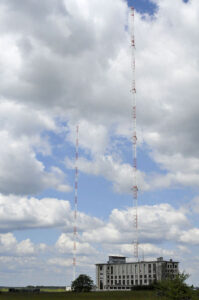
The longwave transmitter in Allouis [WikiMedia Commons]
I was able to make a short video demonstrating the effect without the need to use headphones, using its name giver, Radio Luxemburg. More precisely it’s the newer transmitter in Beidweiler, which replaced the nearby Junglinster transmitter in 1972. The reason why I felt an urge to do this and write about it is sad though: RTL 234kHz is yet another station that is said to abandon longwave by the end of this year “due to dramatically increased operation costs“, and this means the chances to observe and study the effect so clearly and conveniently will be gone:
In the video, I’m constantly switching between ALS162 and RTL on 234kHz to show the origin of the ionospheric modification/modulation and the outcome on 162kHz. I’m also switching between AM and LSB because the modulation is usually very weak in relation to the carrier; SSB is taking the carrier out of the equation and presents the modulation only, which makes it much easier to detect. I also corrected the volume of all signals a bit to make more obvious what’s happening.
The effect doesn’t sound exactly spectacular but how it comes into existence, that a strong station can modify the conductivity of the ionosphere directly and so quickly that it carries audio frequency modulation was certainly exiting in the 1930s, it’s still pretty exiting (not only) to me!
From Beromünster to HAARP
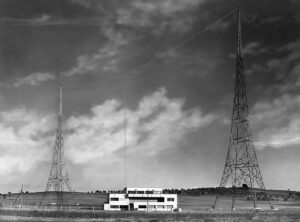
The first Beromünster medium wave T-antenna 1931 [www.sarganserland-walensee.ch]
The discovery of this effect eventually sparked the idea that the ionosphere could be purposely modified by man: In the 1960s studies using the Arecibo facility took place and a number of “ionospheric pumps” or “heaters” were built all over the world, culminating in the conception of HAARP and its ionospheric research instrument (IRI) in the early 1990s. One purpose of that massive antenna field was to examine the possibility of using the ionosphere and the Luxemburg effect as an integral part of VLF communications: The idea may have been that the ionosphere itself could be made to emit very low frequencies for long-range communication with submerged submarines, much easier and cheaper than the huge conventional VLF stations could. As we all know, HAARP and its predecessors were much more successful in sparking weird theories about what they (allegedly) really do.
The legal heir of HAARP, the university of Fairbanks, AK is still conducting experiments to create artificial aurora and to study the Luxemburg-Gorky effect as reported here on the SWLing Post just recently.
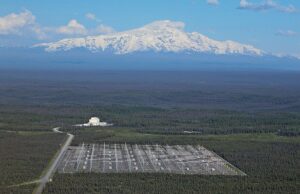
The High Frequency Active Auroral Research Program site, Gakona, AK [U.S. Air Force photograph]
Some personal observations
The theory is that the station to be modulated, the modulating station and the receiver must be ideally aligned in a straight line. However, this may not be entirely accurate because there are reports from listeners abeam of the 2 stations, I have confirmed that using KiwiSDRs in Bavaria and I’m not exactly located at the end of a straight line either. Observing the effect for the past weeks I noticed the relation between solar activity and the severity of the effect: In quiet periods with low A- and K-indices the effect cannot be observed during the day in my northerly position, in the aftermath of flares causing geomagnetic storms and radio blackouts I heard it even at noon. Interestingly, this seems to have influence on the range in which the effect could be observed more than the signal strength of the 2 stations: The Twente SDR in Enschede (NL) is much closer to Luxemburg and has modulation on 162kHz all day, even in quiet space weather!
If you’re interested in the science of the effect, here’s a few documents I found during research:
- http://jultika.oulu.fi/files/isbn9789514289163.pdf
- https://scholarship.rice.edu/bitstream/handle/1911/90106/RICE1142.pdf
- Click to access https://agupubs.onlinelibrary.wiley.com/doi/full/10.1002/2017RS006525
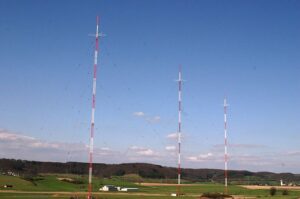
The newer Radio Luxemburg long wave transmitter in Beidweiler [WikiMedia Commons]
Try that at home!
You can observe the effect yourself using the famous Twente University WebSDR in Enschede, Holland, wherever you are! Just tune to 162 kHz and listen, if you don’t hear much switch to LSB or USB. Unfortunately there are merely weeks left to become an earwitness of the famous and elusive “Luxemburg (-Gorky) effect”.

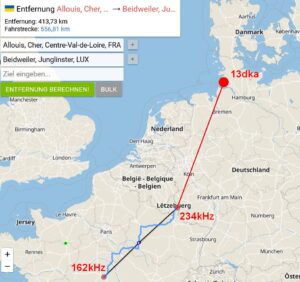
Thank you! I’ve just observed the effect on the UTwente SDR. I had heard about the HAARP experiments in the past, but to actually hear it in action is quite something. I really appreciate the effort you put into this post.
And 136 papers found in Google Scholar (10 not dated) for “Luxemburg-Gorky-effect”
Many recent.
Here is Most relevant 20 sorted by RANK in a Comma-separated-variable format
Authors,Title,Year,Source,Publisher,ArticleURL,CitesURL,GSRank
“VY Zaitsev, V Gusev, B Castagnede”,Observation of the “Luxemburg–Gorky effect” for elastic waves,2002,Ultrasonics,Elsevier,https://www.sciencedirect.com/science/article/pii/S0041624X02001877,”https://scholar.google.com/scholar?cites=18413394289586550549&as_sdt=2005&sciodt=0,5&hl=en”,1
“V Zaitsev, V Gusev, B Castagnede”,Luxemburg-Gorky effect retooled for elastic waves: A mechanism and experimental evidence,2002,Physical review letters,APS,https://journals.aps.org/prl/abstract/10.1103/PhysRevLett.89.105502,”https://scholar.google.com/scholar?cites=7233376167387320256&as_sdt=2005&sciodt=0,5&hl=en”,2
“VY Zaitsev, VE Nazarov, V Tournat…”,Luxemburg-Gorky effect in a granular medium: probing perturbations of the material state via cross-modulation of elastic waves,2005,EPL (Europhysics …,iopscience.iop.org,https://iopscience.iop.org/article/10.1209/epl/i2005-10023-5/meta,”https://scholar.google.com/scholar?cites=15520355509970499132&as_sdt=2005&sciodt=0,5&hl=en”,3
“T Trojniar, A Klepka, L Pieczonka…”,Fatigue crack detection using nonlinear vibro-acoustic cross-modulations based on the Luxemburg-Gorky effect,2014,Health Monitoring of …,spiedigitallibrary.org,https://www.spiedigitallibrary.org/conference-proceedings-of-spie/9064/90641F/Fatigue-crack-detection-using-nonlinear-vibro-acoustic-cross-modulations-based/10.1117/12.2046471.short,”https://scholar.google.com/scholar?cites=5592831632410654595&as_sdt=2005&sciodt=0,5&hl=en”,4
“V Zaitseva, BC VitaliGoussevb”,The “Luxemburg-Gorky Effect” for Elastic Waves: Observation and Possible Mechanism,,perso.univ-lemans.fr,,http://perso.univ-lemans.fr/~bcasta/Publications%20conferences/CFA2002.pdf,,5
“V Zaitsev, V Gusev, B Castagnede”,The Luxemburg-Gorky Effect Revived for Elastic Waves: a Mechanism and Experimental Evidence,,perso.univ-lemans.fr,,http://perso.univ-lemans.fr/~bcasta/Publications%20conferences/ISNA2001ter.pdf,,6
“M Osika, A Ziaja-Sujdak, R Radecki…”,Experimental Investigation of Modulation Transfer Phenomenon Due to Shear Horizontal Ultrasonic Wave Interaction with Local Nonlinearity,2023,European Workshop on …,Springer,https://link.springer.com/chapter/10.1007/978-3-031-07254-3_20,,7
“VP Yakubov, SE Shipilov, RN Satarov, AV Yurchenko”,Remote ultra-wideband tomography of nonlinear electronic components,2015,Technical Physics,Springer,https://link.springer.com/article/10.1134/S1063784215020267,”https://scholar.google.com/scholar?cites=13043646240357220060&as_sdt=2005&sciodt=0,5&hl=en”,8
“J Górski, A Klepka”,Application of Modulation Transfer Effect to Damage Detection,2020,Proceedings of the 13th International Conference on …,Springer,https://link.springer.com/chapter/10.1007/978-981-13-8331-1_9,,9
VL Ginzburg,The theory of Luxemburg–Gorky effect,1948,”Izvestiya Akademii Nauk SSR, Seriya Fizicheskaya”,,,”https://scholar.google.com/scholar?cites=15737449594952111022&as_sdt=2005&sciodt=0,5&hl=en”,10
All but the last one deal with the L-G-effect analogies in material/solid state physics and acoustics though. 🙂
I believe this effect has been replicated and verified with HAARP.
And at the end of my recording of the last hour of France Inter on 162 kHz, you can hear TWO stations via the Luxembourg Effect (RTL and Europe 1):
https://shortwavearchive.com/archive/france-inter-longwave-162-khz-final-sign-off-december-31-2016
Oh wow, that’s a nice contemporary document! It didn’t come to me that someone may have recorded the France Inter sign-off!
And who said physics was boring?!
Pieter-Tjerk (PA3FWM) has a small page on the Luxembourg effect too: https://pa3fwm.nl/signals/luxembourgeffect and a larger article in the VERON Electron.
Thanks! The 3rd link in the small collection in the article leads to the newest (and most interesting if I may say so) of the papers was written by Pieter-Tjerk de Boer and M.Vester, it goes a bit more into the details of the sideband asymmetry he wrote about on his website. Pieter-Tjerk is also a lecturer at the Twente university BTW. 🙂